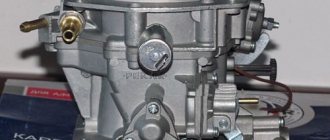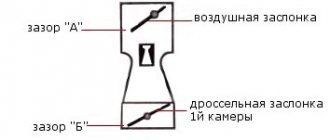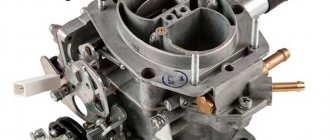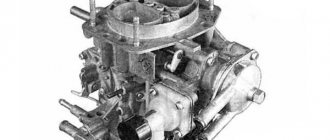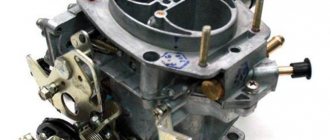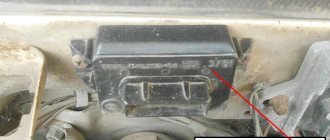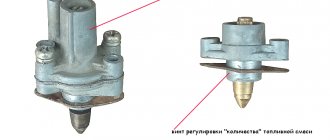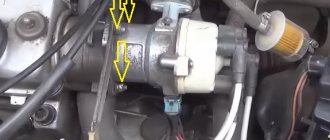Electronic carburetor control in its standard version has several components, among which the most important role is played by the solenoid valve. This element of the fuel distribution mechanism is responsible for stabilizing and fine-tuning the idle speed of the engine, which ultimately allows the owner of the carburetor unit to save tens of thousands of rubles on fuel annually. We will talk in more detail about what this miracle unit is, how it works and what kind of breakdowns it is susceptible to in the material presented below.
Operating principle
To determine the cause of the problem and take action to troubleshoot the EPHH, you need to know about the principle of its operation.
- The economizer is equipped with output and input circuits.
- The input circuits are a limit switch and a wire that connects to the switch.
- The throttle (throttle) limit switch tells the economizer whether the gas pedal is depressed or not at that particular moment.
- If the pedal is not depressed, the limit switch closes to ground.
- As soon as the gas pedal is pressed by the driver, the contact is switched off.
- The wire that connects the switch and the economizer reports the number of pulses to the ignition coil. In fact, due to this, the economizer is able to find out about the actual current speed of the power unit.
- The EPHH has only one output circuit - the XX solenoid valve of the carburetor system (XX - idle speed). The economizer can turn this valve on and off.
- Fuel economy is ensured by closing the XX fuel jet at high engine speeds.
- If the gas pedal is not depressed, the throttle limit switch closes to ground, the speed is less than 2.1 thousand per minute, then the economizer opens the XX solenoid valve.
- When the gas pedal is depressed, the limit switch opens, leaving the valve open anyway. The valve closes only when the engine speed exceeds 2.1 thousand per minute.
- The valve is in the closed position until the speed drops below 1.9 thousand per minute.
If the car is coasting with the gear engaged and the accelerator pedal released, the EPHH will not turn on, even if the revolutions drop below 1900 per minute. The economizer monitors the closed position of the damper. If the engine speed at idle is too high, it is perceived as coasting.
Actually, this is all you need to know about the operation of such an element as EPHH.
Practice and research show that the use of an economizer allows you to save about 5 percent of engine consumption.
Carburetor economizer device
The unit is designed as a separate module in its own housing. The actuator is located inside and cannot be serviced. On the outside is the electrical part with the connection connector contacts, on the inside (located in the cavity of the carburetor chambers) is the valve head. If the economizer has a mechanical drive, there are no connection wires.
It serves to control the fuel supply. The control module receives data from various sensors (the system works almost like an injector), and, based on the installed factory program, gives commands to the actuators. Accordingly, the mechanical unit operates when the conditions for actuation of the drive are created. The following types of devices are installed on most carburetors:
Forced idle economizer (abbreviation: EPHH)
The device is designed as a technical development of the idle air valve. At the same time, it also has unique functions. The valve can completely shut off the flow of fuel through the idle jet. The control controller receives two signals: a certain number of crankshaft revolutions, and the absence of movement of the accelerator pedal. The system allows you to significantly save fuel when braking the engine. Compression of the cylinders dampens the crankshaft speed, while gasoline does not enter the combustion chambers. Accordingly, there is no negative effect when unburned fuel enters the muffler and burns there. Previously, drivers switched to neutral gear to save money on long descents. This is unsafe and also causes the car to overheat and wear out the brakes. In gear driving mode, car control is more predictable, and there is always the opportunity to slow down with cold pads, which cannot be done when coasting.
When communicating with professional service technicians, you may hear the abbreviation EMV (solenoid valve). This is a slang name for EPPH.
The photo shows how the EPPH is located and how to dismantle it.
Power mode economizer (EMR).
Technically designed like a vacuum regulator. It operates in mechanical mode, which makes it reliable and easy to maintain. The economizer diaphragm ensures a normally open valve (based on the principle of electromagnetic relays). Only instead of a coil and a core, a ball and a spring are used.
The location and components of the EMR can be seen in the illustration:
An open ball valve allows gasoline to pass freely through the nozzle channel. Under moderate loads, a natural vacuum occurs in the carburetor chamber, driving the economizer membrane (diaphragm). This force is greater than the resistance of the ball spring. The additional flow of gasoline stops, resulting in fuel savings. When you press the accelerator harder, the vacuum decreases and the membrane goes into rest mode. The system again opens an additional flow of gasoline, providing additional power pickup due to forced enrichment of the mixture.
Valve check
There are three main steps to checking the functionality of the solenoid valve.
Verification method
Your actions
Basic operating mode of EPHH
Engine braking mode
Fuel cut-off when ignition is turned off
In addition to the solenoid valve itself, you should also definitely check the EPHH control unit.
Plus and minus
Checking the control unit
To check the control unit of the solenoid valve of the carburetor VAZ 2109 you will need a wire. The length of the wire should be such that it is sufficient to connect the valve to the positive terminal of the battery. Plus, you will need a standard voltage control light.
Your steps when checking the control unit will look like this.
- Disconnect the power wire from the valve without interfering with the operation of the carburetor itself. After this, connect the valve via the prepared wire to the positive terminal of the battery.
- The supply wire of the solenoid valve, which you disconnected in the previous step, must be connected to the positive terminal of the control lamp. The minus connects to the mass.
- Turn on the engine and let it idle for a while. The crankshaft should rotate at a speed within 850-900 rpm. The control lamp should light up.
- Begin to gradually increase the speed, reaching 2100 units per minute. If the control unit is working properly, when this level is reached, the light will go out. Reducing the speed again to 1900 units per minute, the lamp should light up.
Useful diagram
If a malfunction was discovered during the check of the valve and its control unit, it will be necessary to replace the corresponding failed components of the carburetor power system of the VAZ 2109.
Symptoms of a problem
There are several main signs indicating failure of the EPHH:
- The engine regularly stalls at idle;
- Detonation occurs in the engine when the ignition is turned off;
- The engine stalls when coasting braking is performed.
You can check whether the EPHH and its control unit are working correctly with your own hands. To check the valve, you should monitor its activation in various operating modes. Correct operation is determined by ear or using a voltmeter.
Diagnostics and repair of EPHH
How to check the main carburetor systems, remove it from the intake manifold and drain the fuel, read the article (Carburetor). Also carefully read the article (safety precautions for car repair and maintenance), this will help you avoid fuel fires.
You can replace the EPHH or clean its jet without removing the carburetor. Remove the air filter, disconnect the wire from the economizer and unscrew it from the carburetor body. Remove the jet from the plastic drive and wash it. Using two wires, connect the EPHH to the battery; if the drive retracts more than 5 mm, the economizer is working. If not, it needs to be replaced. Don't forget to bleed the entire idle system. To do this, spray carburetor cleaner into the hole for installing EPHH and after 1 minute blow it out with a compressor.
Carry out any work related to the EMR only on a removed carburetor, draining the fuel from it. Place the bottom of the carburetor on a clean table and remove the 3 screws securing the cover and diaphragm. Remove the cap and diaphragm, being careful not to lose the spring. Remove the vacuum ignition timing regulator hose and place it on the valve. Try to suck air through this hose. If the valve is working properly, then air will not pass through. If air passes through, the valve must be replaced.
The DAAZ plant, the main supplier of carburetors for VAZ cars, does not produce spare valves, so it will either have to be removed from another carburetor, or products from other manufacturers will have to be used. To remove the valve, you will need a flat head screwdriver and a blow torch. Using a blowtorch, heat the bottom of the carburetor to a temperature of 100–120 degrees and use duckbills to pull the valve out of the seat. Do not overheat the carburetor. When the carburetor has cooled, be sure to clean all EMR passages. Before installing a new valve, heat the carburetor to 80–90 degrees. Then insert the new valve and, using light blows, through a mandrel whose internal diameter is slightly larger than the cut valve tube, press it into place. When the carburetor has cooled, install a new diaphragm, spring and EMR cover. Tighten the screws and assemble the carburetor, then install it in place.
Video - Installation of the EPHH system
An increase in fuel consumption can be due to many factors, including improper operation of the EMR. If the valve spring is weakened or broken, the economizer valve will be constantly open, re-enriching the air-fuel mixture. When the gas pedal is fully pressed, this increases engine power, but in other modes, on the contrary, it leads to a drop in power. Because of this, the driver is forced to press harder on the gas, which further increases fuel consumption. If the EMR diaphragm has lost its seal or the cap is not tightened properly, gasoline will enter the intake manifold below the throttle valve and also leak out. The latter is especially dangerous because it can cause fuel to ignite.
